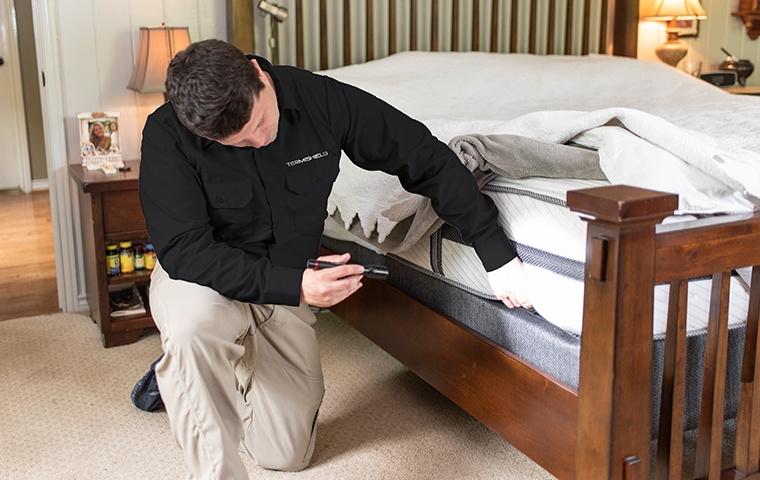Kings Cincinnati Bug Control Companies: Reliable Services
Kings Cincinnati Bug Control Companies: Reliable Services
Blog Article
Kinds Of Bug Control: Which Technique Is Right for Your Invasion?
When faced with an insect infestation, the option of a proper technique for pest control is essential in efficiently managing the scenario. By checking out the various kinds of parasite control approaches offered, individuals can make enlightened decisions customized to their one-of-a-kind scenarios, making sure a more reliable and sustainable end result in bug eradication.
Chemical Parasite Control
Chemical insect control entails the usage of synthetic or normally acquired chemicals to manage and get rid of pest populations properly. This method is generally made use of in agriculture, forestry, and property settings to deal with a large range of pests, consisting of rodents, weeds, and pests. Making use of chemical pesticides can offer fast and targeted services to pest invasions, making it a preferred option for several individuals and services.
Among the essential benefits of chemical insect control is its capacity to promptly eliminate bugs, lowering the risk of damages to plants, home, and human wellness. By utilizing particular chemicals that target certain pests, this method can successfully manage problems while lessening injury to useful microorganisms and the setting when used correctly.
Nonetheless, the use of chemical insect control likewise increases worries concerning possible adverse effects on non-target species, water sources, and human health. It is important to adhere to safety guidelines, apply chemicals responsibly, and think about alternate insect control approaches to decrease these threats and make certain lasting parasite monitoring methods.
Organic Bug Control
Organic bug control, likewise recognized as biocontrol, uses living organisms to handle and decrease parasite populations normally. By utilizing the pest's all-natural predators or microorganisms, organic insect control offers a ecologically friendly and lasting service to pest management.

Mechanical Parasite Control
Utilizing manual and physical methods to take care of parasite populaces, mechanical parasite control offers an alternative approach that does not count on using living microorganisms or synthetic chemicals. This technique includes the use of barriers, catches, or various other gadgets to physically prevent or remove parasites. By obstructing insect entry factors or establishing traps to catch them, mechanical pest control can properly lower invasions without introducing chemicals right into the atmosphere.
One typical example of mechanical parasite control is making use of mesh screens on home windows and doors to avoid insects from getting in structures. This easy yet effective approach serves as a physical barrier, maintaining insects out while permitting correct ventilation. In addition, gadgets like mousetraps, fly swatters, and ultrasonic repellents fall under the mechanical bug control classification.
While mechanical pest control techniques can be labor-intensive and call for normal tracking and maintenance, they use a ecologically friendly and lasting solution for handling pest invasions. By combining different mechanical methods, home proprietors can create a thorough insect control approach that minimizes dependence on chemical pesticides.
Physical Pest Control

Some common physical pest control techniques include making use of obstacles such as nets or displays to protect against parasite access, traps to capture and remove parasites, and hand-picking to literally eliminate bugs from plants or structures. Additionally, strategies like warmth treatments can be used to regulate bugs like bed bugs by raising the temperature level to levels that are lethal to the pests.
Physical bug control is particularly valuable in integrated insect monitoring (IPM) methods, where numerous bug control techniques are integrated for effective bug administration while decreasing making use of chemicals. By using physical insect control strategies, individuals can effectively resolve insect infestations with marginal environmental influence.
Integrated Pest Monitoring
When executing physical parasite control methods as component of pest administration strategies, Integrated Bug Management (IPM) arises as a comprehensive strategy that leverages different strategies to efficiently regulate pest populaces. IPM concentrates on lasting avoidance of pests with a mix of biological, cultural, physical, and chemical devices customized to particular insect concerns. By integrating multiple control techniques, IPM intends to reduce the dangers connected with bugs while also decreasing dependence on chemical remedies.
One key aspect of IPM is the emphasis on tracking and assessing pest populations to figure out one of the most appropriate control methods. This positive approach permits very early treatment and targeted strategies, resulting in much more effective bug monitoring. In addition, IPM promotes environmentally friendly practices by prioritizing non-chemical control methods and only using chemicals as a last resource.
Conclusion

By utilizing the insect's all-natural predators or pathogens, biological bug control provides a sustainable and ecologically pleasant solution to pest management. - Kings Bed bug exterminator Cincinnati
Utilizing physical and hands-on approaches to take care of parasite populations, mechanical pest control offers an alternate technique that does not count on the usage of living microorganisms or artificial chemicals.A reliable strategy to taking care of pest populaces without relying on chemical or biological methods involves the usage of physical pest control strategies.When implementing physical pest control approaches as part of pest management techniques, Integrated Pest Management (IPM) arises as a thorough strategy that leverages numerous strategies to properly regulate pest populaces. Chemical insect control involves the usage of chemicals, biological insect control uses natural predators, mechanical parasite control entails physical obstacles, physical parasite control consists of trapping go to website or removing her explanation pests, and incorporated bug administration combines numerous techniques for a holistic approach to pest control.
Report this page